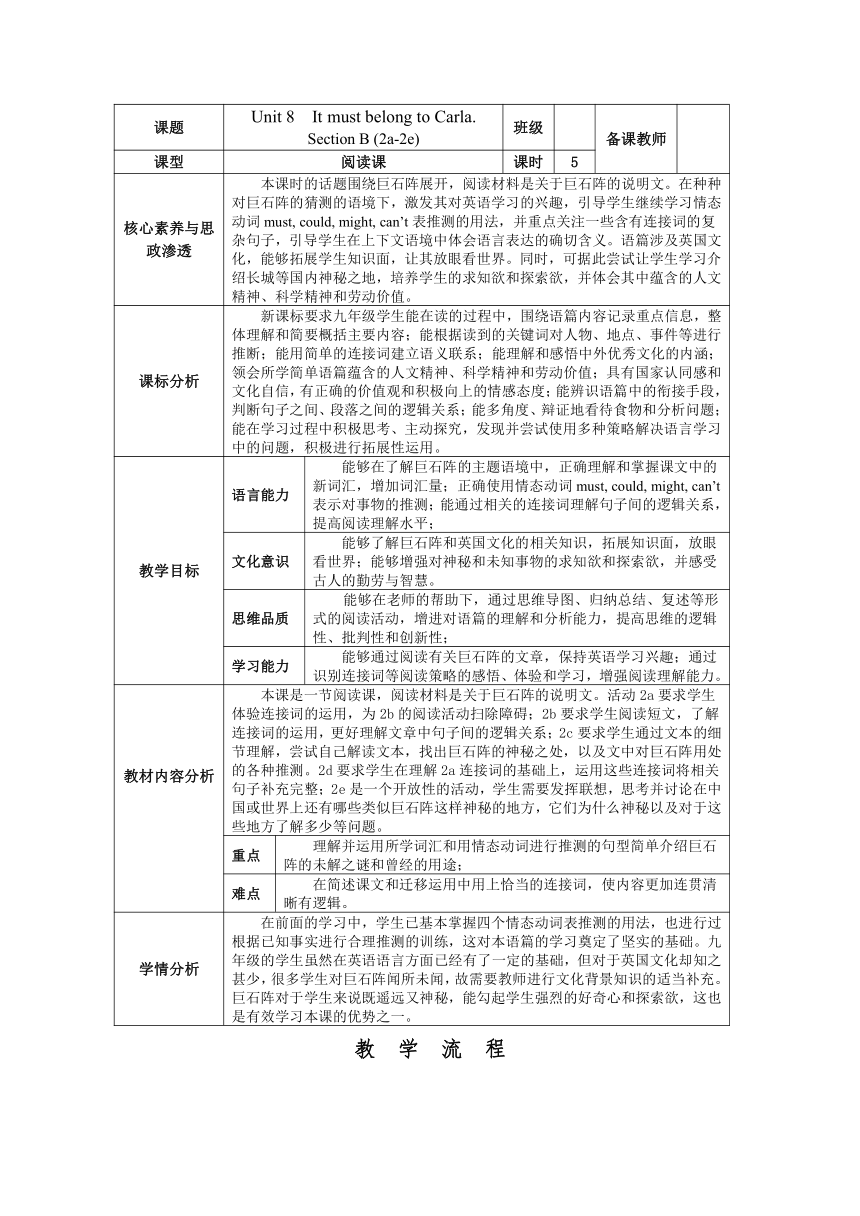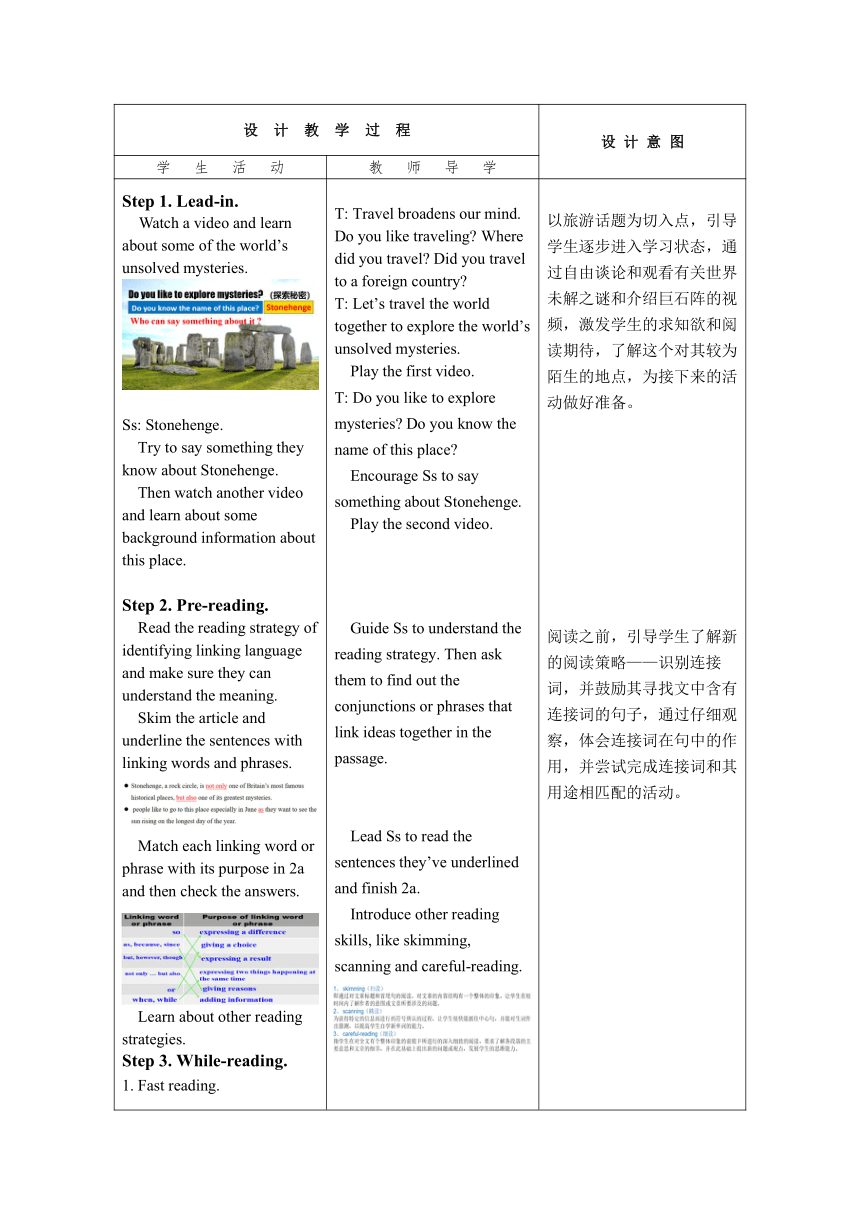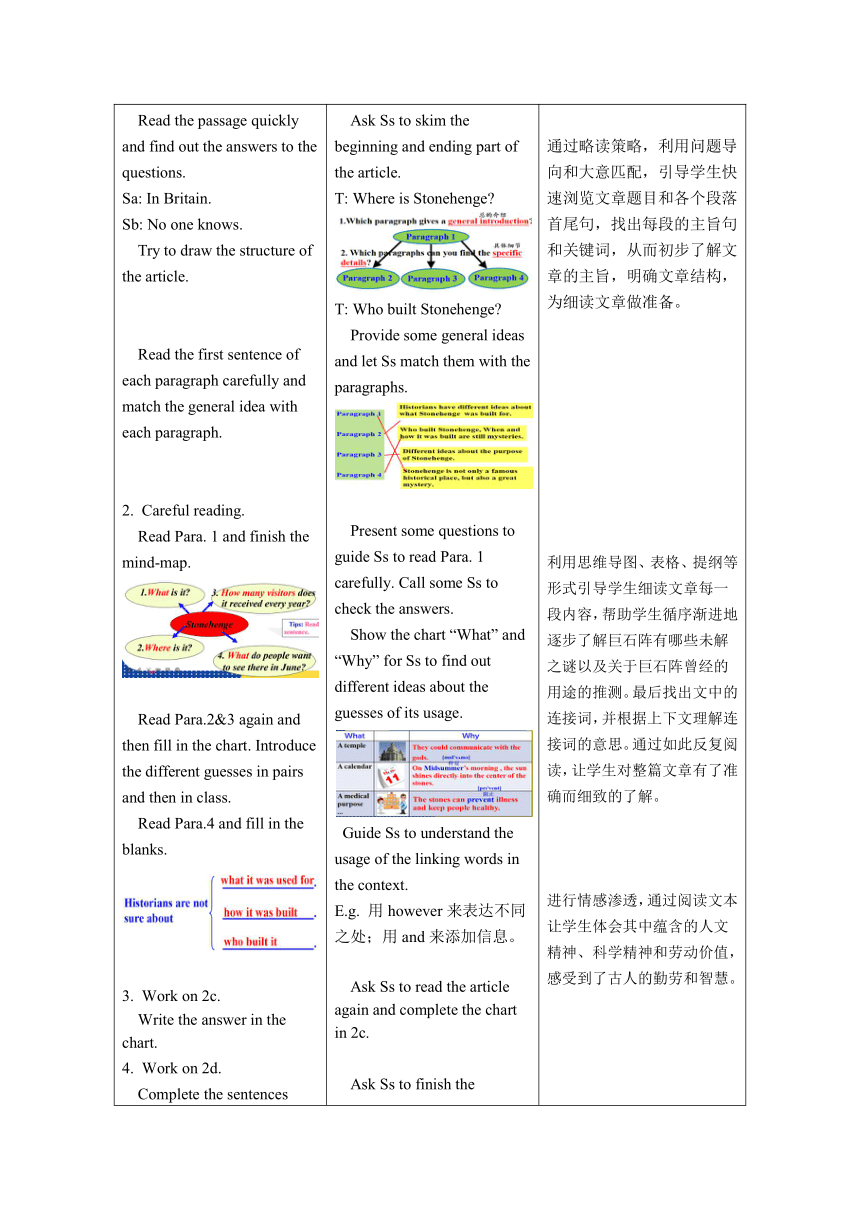人教版九年级全册 Unit 8 It must belong to Carla Section B 2a-2e教学设计(表格式,含核心素养目标)
文档属性
| 名称 | 人教版九年级全册 Unit 8 It must belong to Carla Section B 2a-2e教学设计(表格式,含核心素养目标) |  | |
| 格式 | docx | ||
| 文件大小 | 828.8KB | ||
| 资源类型 | 教案 | ||
| 版本资源 | 人教新目标(Go for it)版 | ||
| 科目 | 英语 | ||
| 更新时间 | 2024-09-24 11:08:38 | ||
图片预览



文档简介
课题 Unit 8 It must belong to Carla. Section B (2a-2e) 班级 备课教师
课型 阅读课 课时 5
核心素养与思政渗透 本课时的话题围绕巨石阵展开,阅读材料是关于巨石阵的说明文。在种种对巨石阵的猜测的语境下,激发其对英语学习的兴趣,引导学生继续学习情态动词must, could, might, can’t表推测的用法,并重点关注一些含有连接词的复杂句子,引导学生在上下文语境中体会语言表达的确切含义。语篇涉及英国文化,能够拓展学生知识面,让其放眼看世界。同时,可据此尝试让学生学习介绍长城等国内神秘之地,培养学生的求知欲和探索欲,并体会其中蕴含的人文精神、科学精神和劳动价值。
课标分析 新课标要求九年级学生能在读的过程中,围绕语篇内容记录重点信息,整体理解和简要概括主要内容;能根据读到的关键词对人物、地点、事件等进行推断;能用简单的连接词建立语义联系;能理解和感悟中外优秀文化的内涵;领会所学简单语篇蕴含的人文精神、科学精神和劳动价值;具有国家认同感和文化自信,有正确的价值观和积极向上的情感态度;能辨识语篇中的衔接手段,判断句子之间、段落之间的逻辑关系;能多角度、辩证地看待食物和分析问题;能在学习过程中积极思考、主动探究,发现并尝试使用多种策略解决语言学习中的问题,积极进行拓展性运用。
教学目标 语言能力 能够在了解巨石阵的主题语境中,正确理解和掌握课文中的新词汇,增加词汇量;正确使用情态动词must, could, might, can’t表示对事物的推测;能通过相关的连接词理解句子间的逻辑关系,提高阅读理解水平;
文化意识 能够了解巨石阵和英国文化的相关知识,拓展知识面,放眼看世界;能够增强对神秘和未知事物的求知欲和探索欲,并感受古人的勤劳与智慧。
思维品质 能够在老师的帮助下,通过思维导图、归纳总结、复述等形式的阅读活动,增进对语篇的理解和分析能力,提高思维的逻辑性、批判性和创新性;
学习能力 能够通过阅读有关巨石阵的文章,保持英语学习兴趣;通过识别连接词等阅读策略的感悟、体验和学习,增强阅读理解能力。
教材内容分析 本课是一节阅读课,阅读材料是关于巨石阵的说明文。活动2a要求学生体验连接词的运用,为2b的阅读活动扫除障碍;2b要求学生阅读短文,了解连接词的运用,更好理解文章中句子间的逻辑关系;2c要求学生通过文本的细节理解,尝试自己解读文本,找出巨石阵的神秘之处,以及文中对巨石阵用处的各种推测。2d要求学生在理解2a连接词的基础上,运用这些连接词将相关句子补充完整;2e是一个开放性的活动,学生需要发挥联想,思考并讨论在中国或世界上还有哪些类似巨石阵这样神秘的地方,它们为什么神秘以及对于这些地方了解多少等问题。
重点 理解并运用所学词汇和用情态动词进行推测的句型简单介绍巨石阵的未解之谜和曾经的用途;
难点 在简述课文和迁移运用中用上恰当的连接词,使内容更加连贯清晰有逻辑。
学情分析 在前面的学习中,学生已基本掌握四个情态动词表推测的用法,也进行过根据已知事实进行合理推测的训练,这对本语篇的学习奠定了坚实的基础。九年级的学生虽然在英语语言方面已经有了一定的基础,但对于英国文化却知之甚少,很多学生对巨石阵闻所未闻,故需要教师进行文化背景知识的适当补充。巨石阵对于学生来说既遥远又神秘,能勾起学生强烈的好奇心和探索欲,这也是有效学习本课的优势之一。
教 学 流 程
设 计 教 学 过 程 设 计 意 图
学 生 活 动 教 师 导 学
Step 1. Lead-in. Watch a video and learn about some of the world’s unsolved mysteries. Ss: Stonehenge. Try to say something they know about Stonehenge. Then watch another video and learn about some background information about this place. Step 2. Pre-reading. Read the reading strategy of identifying linking language and make sure they can understand the meaning. Skim the article and underline the sentences with linking words and phrases. Match each linking word or phrase with its purpose in 2a and then check the answers. Learn about other reading strategies. Step 3. While-reading. 1. Fast reading. Read the passage quickly and find out the answers to the questions. Sa: In Britain. Sb: No one knows. Try to draw the structure of the article. Read the first sentence of each paragraph carefully and match the general idea with each paragraph. Careful reading. Read Para. 1 and finish the mind-map. Read Para.2&3 again and then fill in the chart. Introduce the different guesses in pairs and then in class. Read Para.4 and fill in the blanks. Work on 2c. Write the answer in the chart. Work on plete the sentences with the correct linking words. Then check the answers. Step 4. Post-reading. Retelling. According to the pictures and key word, retell the passage in pairs and then in class. Group work. Work in groups. Suppose they are a tour guide and some tourists. Discuss the mysterious places and introduce a mysterious place in groups and then in class. Step 5. Practice. Read a passage about the Great Wall and fill in the blanks in the chart. Step 6. Summary. Listen to the T to explain some language points and take notes. Have a summary of the passage with T’s help. T: Travel broadens our mind. Do you like traveling Where did you travel Did you travel to a foreign country T: Let’s travel the world together to explore the world’s unsolved mysteries. Play the first video. T: Do you like to explore mysteries Do you know the name of this place Encourage Ss to say something about Stonehenge. Play the second video. Guide Ss to understand the reading strategy. Then ask them to find out the conjunctions or phrases that link ideas together in the passage. Lead Ss to read the sentences they’ve underlined and finish 2a. Introduce other reading skills, like skimming, scanning and careful-reading. Ask Ss to skim the beginning and ending part of the article. T: Where is Stonehenge T: Who built Stonehenge Provide some general ideas and let Ss match them with the paragraphs. Present some questions to guide Ss to read Para. 1 carefully. Call some Ss to check the answers. Show the chart “What” and “Why” for Ss to find out different ideas about the guesses of its usage. Guide Ss to understand the usage of the linking words in the context. E.g. 用however来表达不同之处;用and来添加信息。 Ask Ss to read the article again and complete the chart in 2c. Ask Ss to finish the sentences on their own first and then share their answers and discuss the reasons in pairs. T: Can you introduce Stonehenge after learning the passage T: Can you think of any other mysteries, either in China or another part of the world, that are similar to Stonehenge Provide some questions to lead Ss to introduce the mysterious places. Let Ss read the passage and complete the chart. Then check the answers in class. T: The boundless universe has all kinds of strange things. Although the mysteries are difficult to explain, we should try our best to study hard and reveal these mysteries one day. Be curious and keep a spirit of searching for the truth forever! 以旅游话题为切入点,引导学生逐步进入学习状态,通过自由谈论和观看有关世界未解之谜和介绍巨石阵的视频,激发学生的求知欲和阅读期待,了解这个对其较为陌生的地点,为接下来的活动做好准备。 阅读之前,引导学生了解新的阅读策略——识别连接词,并鼓励其寻找文中含有连接词的句子,通过仔细观察,体会连接词在句中的作用,并尝试完成连接词和其用途相匹配的活动。 通过略读策略,利用问题导向和大意匹配,引导学生快速浏览文章题目和各个段落首尾句,找出每段的主旨句和关键词,从而初步了解文章的主旨,明确文章结构,为细读文章做准备。 利用思维导图、表格、提纲等形式引导学生细读文章每一段内容,帮助学生循序渐进地逐步了解巨石阵有哪些未解之谜以及关于巨石阵曾经的用途的推测。最后找出文中的连接词,并根据上下文理解连接词的意思。通过如此反复阅读,让学生对整篇文章有了准确而细致的了解。 进行情感渗透,通过阅读文本让学生体会其中蕴含的人文精神、科学精神和劳动价值,感受到了古人的勤劳和智慧。 通过图片和关键词的提示,辅助学生复述课文,巩固内容,增强记忆。 了解巨石阵之后,让学生根据自己已有的知识,分组讨论他们所知的世界未解之谜,依靠集体的力量,拓宽自己的知识面,了解世界各地与众不同的文化,并学习介绍中国文化,将所学知识进行迁移创新。 归纳总结本课所学内容,并进行情感渗透,教育学生在无奇不有的大千世界里,保持好奇心、求知欲和不断寻找真相的探索精神。
第 页
课 时 达 标 检 测
Ⅰ. 选词填空。 prevent visit build purpose medicine lead catch enemy especial history (1)People like to go to the place in June. (2)A group of English volunteers tried another Stonehenge,but they couldn't. (3)They think the stones could illness. (4)The position of the stones must be for a special . (5)She might be running a bus to work. (6)Miss Li is a good and we all believe in her. (7)Her recovery(恢复) is a miracle. (8)Stonehenge attracts plenty of every year. (9)Birds are natural of many insects. (10)Some believed Stonehenge was a temple. Ⅱ. 阅读理解。 Tornadoes(龙卷风) are one of the worst weather events on earth.Each year,tornadoes kill many people.The storms often carry homes, cars and trees from one place to another. And they can also destroy anything when they pass by. A tornado comes from a rainstorm in the sky down to the ground.It is big at the top and small at the bottom. A tornado appears when winds in different directions meet in the cloud and begin to turn in circles.People can see tornadoes almost everywhere in the world. But most happen from late winter to mid﹣summer.There is a second high season in November.During spring warm air moves north and mixes with the cold air left from winter.In November,the opposite(相反的)happens.Cold air moves south and mixes with the cold air left from winter. Tornadoes always come suddenly.Weather scientists have done something to predict(预测) tornadoes.But the storms often move too fast for people to protect themselves.Last year, tornadoes killed more than one hundred people in United States. Scientists say the best place to be in is a small room,without windows, in the middle the lowest part of a building when tornadoes come. 根据短文内容,选择最佳答案. (1)According to the passage,we know the shape of the tornadoes may be like . (2)In the United States,most tornadoes happen . A.from late summer to middle summer B.from late autumn to middle winter C.from late autumn to middle spring D.from late winter to middle summer (3)According to Paragraph 3,in Spring tornadoes appear when . A.warm air and cold air mix B.cold air and cold air mix C.warm air and warm air mix D.warm water and cold water mix (4)What's the Chinese meaning of the underlined word "destroy"? A.保护 B.珍惜 C.毁灭 D.惩罚 (5)From the passage,we know that . A. the United states has very few tornadoes. B. tornadoes are one of the worst weather events in the world. C. people should stay in big rooms with windows when tornadoes come. D. more than one thousand people were killed by tornadoes in the USA last year.
第 页
课 时 教 学 设 计 尾 页
板 书 设 计
Unit 8 It must belong to Carla. Section B (2a-2e)
作 业 设 计
Level A Work in groups, search for some information about one of the mysterious places in the world and make a brochure named “the Unsolved Secrets of the World”. Share your works in class next week.
Level B Write a brief summary of this passage no more than 150 words.
教 学 反 思
语篇研读: What:本课语篇类型为说明文,主要围绕巨石阵的有关事实和各种对其的推测展开。巨石阵是英国最著名的历史遗迹之一,也是英国最大的谜团之一。它的存在引发了人们的各种猜测,对于其用途,有人认为是神庙,有人觉得是日历,还有人坚信其有治病的神力等。此外,如何建造巨石阵也成为人们所努力探索的谜团之一。 Why:作者通过阐述巨石阵的有关事实和各种对其的推测,使学生在特定的情境中感知和理解情态动词must, could, might, can’t表示猜测的语用功能,并体验和学习识别连接词等阅读策略,以促进其阅读理解能力的提升。同时,使学生明白,尽管巨石阵存在的价值与意义至今还是一个谜团,但不可否认的是,这一建筑让大家真实地感受到了古人的勤劳和智慧,这是人类发展史上的文明结晶,也让我们对之前人们的生活习性,有了更进一步的了解。很多古建筑,都是先辈们留给我们的文化瑰宝,作为新时代的青年,我们最应该做的是努力学习科学文化知识,去勇敢探索未知,大胆猜测并破解其中的谜团,并体会其中所蕴含的人文精神、科学精神和劳动价值。 How:语篇按照说明文的写作风格进行描述,主要分为两部分:第一部分主要介绍有关巨石阵的事实性信息,如巨石阵是英国最著名的历史遗迹之一,也是英国最大的谜团之一,每年吸引着众多的游客前来;第二部分主要介绍人们对于巨石阵用途、建造方式等的各种猜测。文中多次使用情态动词must, could, might, can’t表示人们的不同猜测。并且,作者使用了多个把观点连在一起的连词或短语帮助读者读懂语篇内容,如not only...but also..., as, however, because, but, or, and等。
第 页
课型 阅读课 课时 5
核心素养与思政渗透 本课时的话题围绕巨石阵展开,阅读材料是关于巨石阵的说明文。在种种对巨石阵的猜测的语境下,激发其对英语学习的兴趣,引导学生继续学习情态动词must, could, might, can’t表推测的用法,并重点关注一些含有连接词的复杂句子,引导学生在上下文语境中体会语言表达的确切含义。语篇涉及英国文化,能够拓展学生知识面,让其放眼看世界。同时,可据此尝试让学生学习介绍长城等国内神秘之地,培养学生的求知欲和探索欲,并体会其中蕴含的人文精神、科学精神和劳动价值。
课标分析 新课标要求九年级学生能在读的过程中,围绕语篇内容记录重点信息,整体理解和简要概括主要内容;能根据读到的关键词对人物、地点、事件等进行推断;能用简单的连接词建立语义联系;能理解和感悟中外优秀文化的内涵;领会所学简单语篇蕴含的人文精神、科学精神和劳动价值;具有国家认同感和文化自信,有正确的价值观和积极向上的情感态度;能辨识语篇中的衔接手段,判断句子之间、段落之间的逻辑关系;能多角度、辩证地看待食物和分析问题;能在学习过程中积极思考、主动探究,发现并尝试使用多种策略解决语言学习中的问题,积极进行拓展性运用。
教学目标 语言能力 能够在了解巨石阵的主题语境中,正确理解和掌握课文中的新词汇,增加词汇量;正确使用情态动词must, could, might, can’t表示对事物的推测;能通过相关的连接词理解句子间的逻辑关系,提高阅读理解水平;
文化意识 能够了解巨石阵和英国文化的相关知识,拓展知识面,放眼看世界;能够增强对神秘和未知事物的求知欲和探索欲,并感受古人的勤劳与智慧。
思维品质 能够在老师的帮助下,通过思维导图、归纳总结、复述等形式的阅读活动,增进对语篇的理解和分析能力,提高思维的逻辑性、批判性和创新性;
学习能力 能够通过阅读有关巨石阵的文章,保持英语学习兴趣;通过识别连接词等阅读策略的感悟、体验和学习,增强阅读理解能力。
教材内容分析 本课是一节阅读课,阅读材料是关于巨石阵的说明文。活动2a要求学生体验连接词的运用,为2b的阅读活动扫除障碍;2b要求学生阅读短文,了解连接词的运用,更好理解文章中句子间的逻辑关系;2c要求学生通过文本的细节理解,尝试自己解读文本,找出巨石阵的神秘之处,以及文中对巨石阵用处的各种推测。2d要求学生在理解2a连接词的基础上,运用这些连接词将相关句子补充完整;2e是一个开放性的活动,学生需要发挥联想,思考并讨论在中国或世界上还有哪些类似巨石阵这样神秘的地方,它们为什么神秘以及对于这些地方了解多少等问题。
重点 理解并运用所学词汇和用情态动词进行推测的句型简单介绍巨石阵的未解之谜和曾经的用途;
难点 在简述课文和迁移运用中用上恰当的连接词,使内容更加连贯清晰有逻辑。
学情分析 在前面的学习中,学生已基本掌握四个情态动词表推测的用法,也进行过根据已知事实进行合理推测的训练,这对本语篇的学习奠定了坚实的基础。九年级的学生虽然在英语语言方面已经有了一定的基础,但对于英国文化却知之甚少,很多学生对巨石阵闻所未闻,故需要教师进行文化背景知识的适当补充。巨石阵对于学生来说既遥远又神秘,能勾起学生强烈的好奇心和探索欲,这也是有效学习本课的优势之一。
教 学 流 程
设 计 教 学 过 程 设 计 意 图
学 生 活 动 教 师 导 学
Step 1. Lead-in. Watch a video and learn about some of the world’s unsolved mysteries. Ss: Stonehenge. Try to say something they know about Stonehenge. Then watch another video and learn about some background information about this place. Step 2. Pre-reading. Read the reading strategy of identifying linking language and make sure they can understand the meaning. Skim the article and underline the sentences with linking words and phrases. Match each linking word or phrase with its purpose in 2a and then check the answers. Learn about other reading strategies. Step 3. While-reading. 1. Fast reading. Read the passage quickly and find out the answers to the questions. Sa: In Britain. Sb: No one knows. Try to draw the structure of the article. Read the first sentence of each paragraph carefully and match the general idea with each paragraph. Careful reading. Read Para. 1 and finish the mind-map. Read Para.2&3 again and then fill in the chart. Introduce the different guesses in pairs and then in class. Read Para.4 and fill in the blanks. Work on 2c. Write the answer in the chart. Work on plete the sentences with the correct linking words. Then check the answers. Step 4. Post-reading. Retelling. According to the pictures and key word, retell the passage in pairs and then in class. Group work. Work in groups. Suppose they are a tour guide and some tourists. Discuss the mysterious places and introduce a mysterious place in groups and then in class. Step 5. Practice. Read a passage about the Great Wall and fill in the blanks in the chart. Step 6. Summary. Listen to the T to explain some language points and take notes. Have a summary of the passage with T’s help. T: Travel broadens our mind. Do you like traveling Where did you travel Did you travel to a foreign country T: Let’s travel the world together to explore the world’s unsolved mysteries. Play the first video. T: Do you like to explore mysteries Do you know the name of this place Encourage Ss to say something about Stonehenge. Play the second video. Guide Ss to understand the reading strategy. Then ask them to find out the conjunctions or phrases that link ideas together in the passage. Lead Ss to read the sentences they’ve underlined and finish 2a. Introduce other reading skills, like skimming, scanning and careful-reading. Ask Ss to skim the beginning and ending part of the article. T: Where is Stonehenge T: Who built Stonehenge Provide some general ideas and let Ss match them with the paragraphs. Present some questions to guide Ss to read Para. 1 carefully. Call some Ss to check the answers. Show the chart “What” and “Why” for Ss to find out different ideas about the guesses of its usage. Guide Ss to understand the usage of the linking words in the context. E.g. 用however来表达不同之处;用and来添加信息。 Ask Ss to read the article again and complete the chart in 2c. Ask Ss to finish the sentences on their own first and then share their answers and discuss the reasons in pairs. T: Can you introduce Stonehenge after learning the passage T: Can you think of any other mysteries, either in China or another part of the world, that are similar to Stonehenge Provide some questions to lead Ss to introduce the mysterious places. Let Ss read the passage and complete the chart. Then check the answers in class. T: The boundless universe has all kinds of strange things. Although the mysteries are difficult to explain, we should try our best to study hard and reveal these mysteries one day. Be curious and keep a spirit of searching for the truth forever! 以旅游话题为切入点,引导学生逐步进入学习状态,通过自由谈论和观看有关世界未解之谜和介绍巨石阵的视频,激发学生的求知欲和阅读期待,了解这个对其较为陌生的地点,为接下来的活动做好准备。 阅读之前,引导学生了解新的阅读策略——识别连接词,并鼓励其寻找文中含有连接词的句子,通过仔细观察,体会连接词在句中的作用,并尝试完成连接词和其用途相匹配的活动。 通过略读策略,利用问题导向和大意匹配,引导学生快速浏览文章题目和各个段落首尾句,找出每段的主旨句和关键词,从而初步了解文章的主旨,明确文章结构,为细读文章做准备。 利用思维导图、表格、提纲等形式引导学生细读文章每一段内容,帮助学生循序渐进地逐步了解巨石阵有哪些未解之谜以及关于巨石阵曾经的用途的推测。最后找出文中的连接词,并根据上下文理解连接词的意思。通过如此反复阅读,让学生对整篇文章有了准确而细致的了解。 进行情感渗透,通过阅读文本让学生体会其中蕴含的人文精神、科学精神和劳动价值,感受到了古人的勤劳和智慧。 通过图片和关键词的提示,辅助学生复述课文,巩固内容,增强记忆。 了解巨石阵之后,让学生根据自己已有的知识,分组讨论他们所知的世界未解之谜,依靠集体的力量,拓宽自己的知识面,了解世界各地与众不同的文化,并学习介绍中国文化,将所学知识进行迁移创新。 归纳总结本课所学内容,并进行情感渗透,教育学生在无奇不有的大千世界里,保持好奇心、求知欲和不断寻找真相的探索精神。
第 页
课 时 达 标 检 测
Ⅰ. 选词填空。 prevent visit build purpose medicine lead catch enemy especial history (1)People like to go to the place in June. (2)A group of English volunteers tried another Stonehenge,but they couldn't. (3)They think the stones could illness. (4)The position of the stones must be for a special . (5)She might be running a bus to work. (6)Miss Li is a good and we all believe in her. (7)Her recovery(恢复) is a miracle. (8)Stonehenge attracts plenty of every year. (9)Birds are natural of many insects. (10)Some believed Stonehenge was a temple. Ⅱ. 阅读理解。 Tornadoes(龙卷风) are one of the worst weather events on earth.Each year,tornadoes kill many people.The storms often carry homes, cars and trees from one place to another. And they can also destroy anything when they pass by. A tornado comes from a rainstorm in the sky down to the ground.It is big at the top and small at the bottom. A tornado appears when winds in different directions meet in the cloud and begin to turn in circles.People can see tornadoes almost everywhere in the world. But most happen from late winter to mid﹣summer.There is a second high season in November.During spring warm air moves north and mixes with the cold air left from winter.In November,the opposite(相反的)happens.Cold air moves south and mixes with the cold air left from winter. Tornadoes always come suddenly.Weather scientists have done something to predict(预测) tornadoes.But the storms often move too fast for people to protect themselves.Last year, tornadoes killed more than one hundred people in United States. Scientists say the best place to be in is a small room,without windows, in the middle the lowest part of a building when tornadoes come. 根据短文内容,选择最佳答案. (1)According to the passage,we know the shape of the tornadoes may be like . (2)In the United States,most tornadoes happen . A.from late summer to middle summer B.from late autumn to middle winter C.from late autumn to middle spring D.from late winter to middle summer (3)According to Paragraph 3,in Spring tornadoes appear when . A.warm air and cold air mix B.cold air and cold air mix C.warm air and warm air mix D.warm water and cold water mix (4)What's the Chinese meaning of the underlined word "destroy"? A.保护 B.珍惜 C.毁灭 D.惩罚 (5)From the passage,we know that . A. the United states has very few tornadoes. B. tornadoes are one of the worst weather events in the world. C. people should stay in big rooms with windows when tornadoes come. D. more than one thousand people were killed by tornadoes in the USA last year.
第 页
课 时 教 学 设 计 尾 页
板 书 设 计
Unit 8 It must belong to Carla. Section B (2a-2e)
作 业 设 计
Level A Work in groups, search for some information about one of the mysterious places in the world and make a brochure named “the Unsolved Secrets of the World”. Share your works in class next week.
Level B Write a brief summary of this passage no more than 150 words.
教 学 反 思
语篇研读: What:本课语篇类型为说明文,主要围绕巨石阵的有关事实和各种对其的推测展开。巨石阵是英国最著名的历史遗迹之一,也是英国最大的谜团之一。它的存在引发了人们的各种猜测,对于其用途,有人认为是神庙,有人觉得是日历,还有人坚信其有治病的神力等。此外,如何建造巨石阵也成为人们所努力探索的谜团之一。 Why:作者通过阐述巨石阵的有关事实和各种对其的推测,使学生在特定的情境中感知和理解情态动词must, could, might, can’t表示猜测的语用功能,并体验和学习识别连接词等阅读策略,以促进其阅读理解能力的提升。同时,使学生明白,尽管巨石阵存在的价值与意义至今还是一个谜团,但不可否认的是,这一建筑让大家真实地感受到了古人的勤劳和智慧,这是人类发展史上的文明结晶,也让我们对之前人们的生活习性,有了更进一步的了解。很多古建筑,都是先辈们留给我们的文化瑰宝,作为新时代的青年,我们最应该做的是努力学习科学文化知识,去勇敢探索未知,大胆猜测并破解其中的谜团,并体会其中所蕴含的人文精神、科学精神和劳动价值。 How:语篇按照说明文的写作风格进行描述,主要分为两部分:第一部分主要介绍有关巨石阵的事实性信息,如巨石阵是英国最著名的历史遗迹之一,也是英国最大的谜团之一,每年吸引着众多的游客前来;第二部分主要介绍人们对于巨石阵用途、建造方式等的各种猜测。文中多次使用情态动词must, could, might, can’t表示人们的不同猜测。并且,作者使用了多个把观点连在一起的连词或短语帮助读者读懂语篇内容,如not only...but also..., as, however, because, but, or, and等。
第 页
同课章节目录
- Unit 1 How can we become good learners.
- Section A
- Section B
- Unit 2 I think that mooncakes are delicious!
- Section A
- Section B
- Unit 3 Could you please tell me where the restroom
- Section A
- Section B
- Unit 4 I used to be afraid of the dark.
- Section A
- Section B
- Unit 5 What are the shirts made of?
- Section A
- Section B
- Review of Units 1-5
- Unit 6 When was it invented?
- Section A
- Section B
- Unit 7 Teenagers should be allowed to choose their
- Section A
- Section B
- Unit 8 It must belong to Carla.
- Section A
- Section B
- Unit 9 I like music that I can dance to.
- Section A
- Section B
- Unit 10 You're supposed to shake hands.
- Section A
- Section B
- Review of Units 6-10
- Unit 11 Sad movies make me cry.
- Section A
- Section B
- Unit 12 Life is full of the unexpected
- Section A
- Section B
- Unit 13 We're trying to save the earth!
- Section A
- Section B
- Unit 14 I remember meeting all of you in Grade 7.
- Section A
- Section B
- Review of Units 11-14
